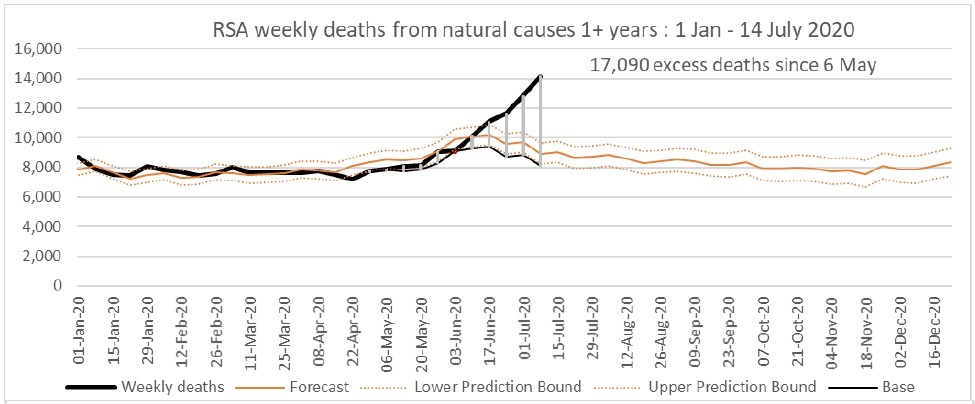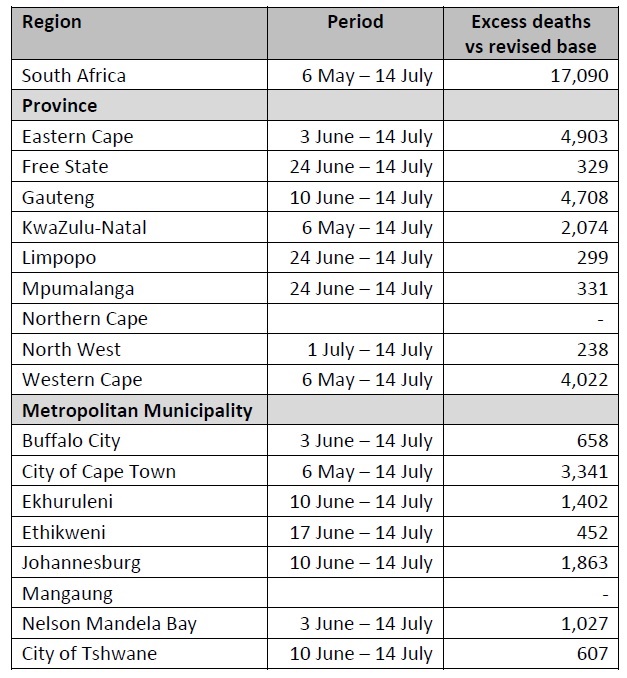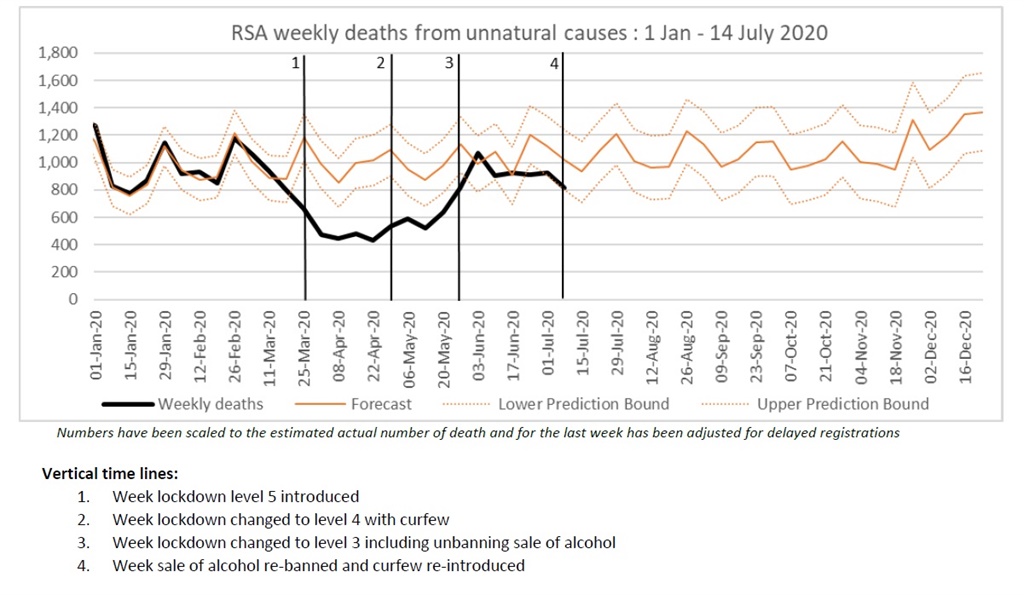- An estimated 17 090 more natural deaths than expected between 6 May and 14 July has raised concern about the accuracy of reported Covid-19 deaths.
- Excess mortality is a measure used internationally to decipher actual deaths during large-scale epidemics.
- It remains unclear why so many South Africans are dying, if it is not related to Covid-19.
South Africans are dying at a much higher rate than expected as Covid-19 continues to spread at a significant pace in at least three provinces.
Excess deaths between 6 May and 14 July topped 17 000, according to the latest research by the South African Medical Research Council (SAMRC) and University of Cape Town’s Centre for Actuarial Research.
“In the past weeks, the numbers have shown a relentless increase – by the second week of July, there were 59% more deaths from natural causes than would have been expected based on historical data. It also means that reported deaths have shown a pattern that is completely different to those indicated by historical trends,” the SAMRC said in a statement on Wednesday.
Professor Debbie Bradshaw, a co-author of the report, said the “timing and geographic pattern leaves no room to question whether this is associated with the Covid-19 epidemic”.
“However, the weekly death reports have revealed a huge discrepancy between the country’s confirmed Covid-19 deaths and the number of excess natural deaths,” she added.
As of 21 July, the number of confirmed Covid-19 deaths was 5 368.
Key takeaways from the latest report for excess mortality up to 14 July:
- Between 6 May and 14 July, excess deaths from natural causes were 17 090 for persons one year and older.
- For people between the ages of one and 59, the excess number of deaths is 5 889 and 11 175 for people 60 and older.
- The Western Cape, Eastern Cape, Gauteng and KwaZulu-Natal are experiencing excess natural deaths. These are the hardest-hit provinces in terms of confirmed Covid-19 deaths and cases.
- Mpumalanga, the Free State, Limpopo and North West have also started showing increases in excess deaths from natural causes.



The number of natural deaths, weekly, nationally. (Source: SAMRC-UCT Weekly Mortality Report 22 July 2020).
The authors of the weekly report include Bradshaw, Ria Laubscher, Professor Rob Dorrington, Professor Pam Groenewald and Professor Tom Moultrie who, together and individually, comprise a highly accomplished and qualified team of some of the country’s foremost experts in demography, statistics and mortality.
Professor Glenda Gray, the CEO and president of the SAMRC, said the council had been tracking mortality for decades.
“This system has identified excess deaths associated with the Covid-19 epidemic. These may be attributed to both Covid-19 deaths as well as non-Covid-19 due to other diseases such as TB, HIV and non-communicable diseases, as health services are re-orientated to support this health crisis,” she added.
Excess deaths
The excess is calculated using the number of reported deaths from the National Population Register (NPR), which is maintained by the Department of Home Affairs. A forecast is calculated based on the number of deaths reported from natural and unnatural causes in past years.
The forecast is also calculated with an upper and lower expectation bound.
The team then uses documented weighting methods to account for multiple variables that could affect the true number of deaths other than what is reported in the NPR data.
According to the SAMRC, there were different ways in which excess deaths were calculated.
“Some analysts take the excess above the expected number based on historical data, while others take the number above a threshold such as the upper prediction bound i.e. significantly higher than expected,” the SAMRC said in a statement on Wednesday.
“In general, these excess deaths are calculated using all-cause mortality. It is considered that excess deaths would comprise Covid-19 deaths that are confirmed, Covid-19 deaths that have not been confirmed, as well as other deaths that may arise from conditions that might normally have been diagnosed and treated had the public been willing and able to access health care.”



Table showing estimated excess deaths as at 14 July. (Source: SAMRC-UCT Weekly Mortality Report 22 July 2020).
In an information sheet shared along with the latest report, the authors acknowledge there was uncertainty about the exact number of excess deaths. They said the uncertainty arose from having to estimate not only the actual number of deaths, but also what would have happened without the Covid-19 pandemic.
“We have reported the challenges that we face and the method that we have used. Our estimate excess natural deaths could be revised should an improved method be identified.
“However, given the timing and geographic spread of the increases seen in the natural deaths, there can be no doubt that the bulk of the increase is related directly or indirectly to Covid-19.”
The authors consider the gap between the number of excess deaths and confirmed Covid-19 deaths probably comprises:
- People dying from Covid-19 before they get to a healthcare facility.
- People dying from Covid-19 but the death not being reported as such.
- People dying from non-Covid-19 conditions because health systems have been orientated to Covid-19 patients.
Testing constraints in the public sector also mean many cases are being picked up only when people arrive at healthcare facilities.
Challenge
“Faced with the challenge that South Africa had a stringent lockdown in the very early stage of the epidemic and that unnatural deaths are a higher proportion of the all-cause mortality [and were impacted very significantly by the stringent lockdown], the SAMRC-UCT team thought it was necessary to use a different approach,” the SAMRC statement read.
The SAMRC said:
To quantify the impact of the Covid-19 epidemic on South African deaths, it was decided to focus on deaths from natural causes and remove the impact of changes in the unnatural deaths.
“The team also thought it would be necessary to consider that the lockdown had reduced the number of natural deaths. Thus, a baseline was chosen that was consistent with the level that the number of natural deaths was tracking prior to the uptick in the trend.”
Bradshaw said the weekly death reports have contributed important information to complement other data on the unfolding of the epidemic.
“The report was able to confirm that no epidemics had occurred prior to the first Covid-19 cases identified by the National Institute for Communicable Diseases (NICD) and the country’s first death announced by Health Minister Dr Zweli Mkhize in March. It was through these reports that the early growth of the epidemic in Cape Town and the Western Cape was confirmed, followed by the spread in Nelson Mandela Bay and the Eastern Cape.”
As of 14 July, the number of deaths from unnatural causes such as car accidents and murders was 20% below expected totals.



The number of unnatural deaths weekly. (Source: SAMRC-UCT Weekly Mortality Report 22 July 2020).
Stay healthy and entertained during the national lockdown. Sign up for our Lockdown Living newsletter. Sign up and manage your newsletters in the new News24 app by clicking on the Profile tab

